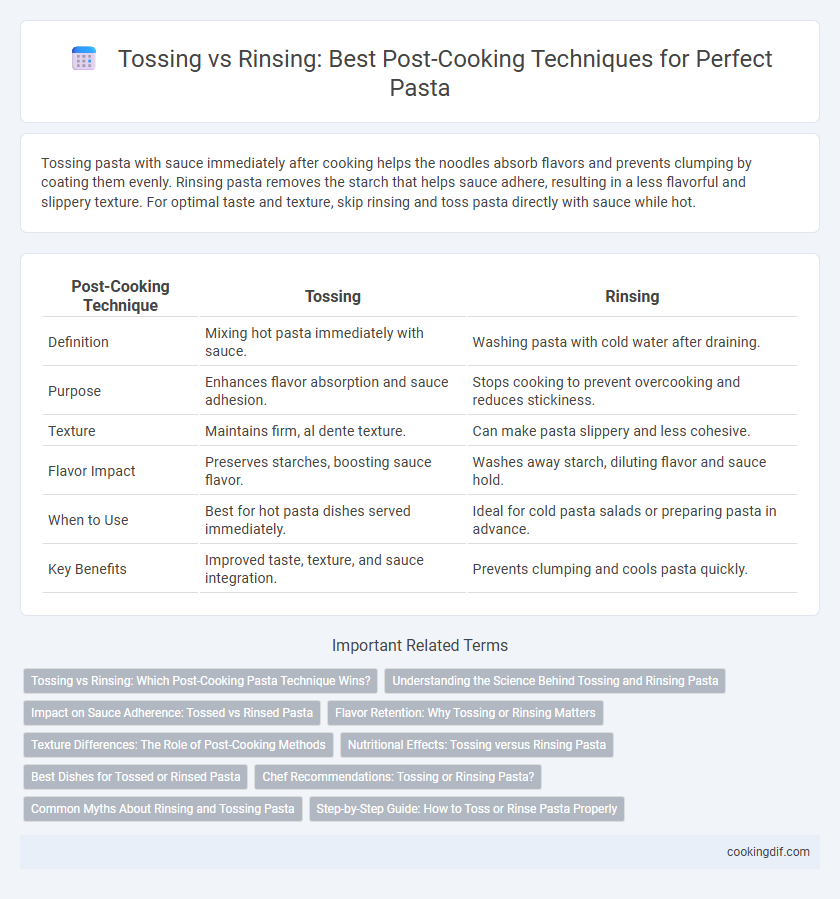Tossing pasta with sauce immediately after cooking helps the noodles absorb flavors and prevents clumping by coating them evenly. Rinsing pasta removes the starch that helps sauce adhere, resulting in a less flavorful and slippery texture. For optimal taste and texture, skip rinsing and toss pasta directly with sauce while hot.
Table of Comparison
| Post-Cooking Technique | Tossing | Rinsing |
|---|---|---|
| Definition | Mixing hot pasta immediately with sauce. | Washing pasta with cold water after draining. |
| Purpose | Enhances flavor absorption and sauce adhesion. | Stops cooking to prevent overcooking and reduces stickiness. |
| Texture | Maintains firm, al dente texture. | Can make pasta slippery and less cohesive. |
| Flavor Impact | Preserves starches, boosting sauce flavor. | Washes away starch, diluting flavor and sauce hold. |
| When to Use | Best for hot pasta dishes served immediately. | Ideal for cold pasta salads or preparing pasta in advance. |
| Key Benefits | Improved taste, texture, and sauce integration. | Prevents clumping and cools pasta quickly. |
Tossing vs Rinsing: Which Post-Cooking Pasta Technique Wins?
Tossing pasta with sauce immediately after draining helps the pasta absorb flavors and prevents clumping by coating each strand evenly. Rinsing pasta washes away the starch that aids sauce adhesion, resulting in a less flavorful and slippery texture. For optimal taste and texture, tossing pasta with sauce is the preferred post-cooking technique over rinsing.
Understanding the Science Behind Tossing and Rinsing Pasta
Tossing pasta immediately after cooking helps coat it evenly with sauce by retaining the pasta's natural starch, which acts as a binder for flavors. Rinsing pasta removes this starch, resulting in a less cohesive dish and a cooler texture, which is ideal only for salads or cold pasta recipes. Understanding that tossing preserves the pasta's heat and starch content enhances sauce absorption, elevating the overall taste and mouthfeel of hot pasta dishes.
Impact on Sauce Adherence: Tossed vs Rinsed Pasta
Tossing pasta immediately with sauce enhances sauce adherence by coating each strand with a thin, even layer, preventing clumping and ensuring balanced flavor distribution. Rinsing pasta removes the surface starch, which significantly reduces the sauce's ability to cling, resulting in a less cohesive and flavorful dish. Optimal sauce adherence is achieved by combining hot, freshly cooked pasta with sauce rather than cooling or rinsing under water.
Flavor Retention: Why Tossing or Rinsing Matters
Tossing pasta with sauce immediately after cooking enhances flavor retention by allowing the starches to bind with the sauce, creating a more cohesive and flavorful dish. Rinsing pasta, on the other hand, washes away the surface starches and can lead to a bland taste and less effective sauce adhesion. For optimal flavor and texture, tossing pasta while still hot with sauce preserves the richness and ensures each bite is well-coated.
Texture Differences: The Role of Post-Cooking Methods
Tossing pasta immediately after cooking preserves its starch coating, enhancing sauce adherence and creating a creamy texture. Rinsing pasta removes surface starch, resulting in a firmer, less sticky bite but reduced sauce absorption. Choosing tossing or rinsing directly impacts pasta's mouthfeel and the overall dish experience.
Nutritional Effects: Tossing versus Rinsing Pasta
Tossing pasta immediately after cooking preserves its natural starches, enhancing sauce adherence and maintaining nutrient retention such as B vitamins and minerals. Rinsing pasta with water removes surface starches but can also wash away water-soluble nutrients, leading to a reduction in overall nutritional value. Choosing to toss rather than rinse supports better flavor absorption and maximizes the pasta's nutritive benefits.
Best Dishes for Tossed or Rinsed Pasta
Tossed pasta, coated with sauce immediately after draining, best suits dishes like spaghetti carbonara, fettuccine Alfredo, and pesto pasta, where the sauce's flavor needs to meld thoroughly with the noodles. Rinsing pasta is ideal for cold dishes such as pasta salads or dishes with vinaigrette-based dressings, where rinsing stops the cooking process and prevents sticking. For creamy or oil-based sauces, tossing preserves optimal texture and flavor absorption, while rinsed pasta maintains freshness and separation in chilled preparations.
Chef Recommendations: Tossing or Rinsing Pasta?
Chefs recommend tossing pasta immediately after cooking to allow the sauce to coat each strand evenly, preserving the pasta's starch for better flavor adherence. Rinsing pasta removes this starch layer, which can lead to a less cohesive dish and diminished sauce absorption. For dishes like pasta salads, rinsing is advised, but for hot pasta recipes, tossing is the preferred technique to maintain texture and enhance taste.
Common Myths About Rinsing and Tossing Pasta
Rinsing pasta after cooking is often misunderstood as a necessary step to prevent sticking, yet it removes the essential starch that helps sauce adhere, diminishing flavor integration. Tossing pasta immediately with sauce retains this starch, ensuring a glossy, well-coated dish with enhanced taste and texture. Contrary to common myths, rinsing is only recommended for cold pasta preparations like salads, where sauce adhesion is not a priority.
Step-by-Step Guide: How to Toss or Rinse Pasta Properly
To properly toss pasta, drain it directly into a colander and immediately transfer it to the sauce for even coating and enhanced flavor absorption. When rinsing pasta, use cold water to halt the cooking process and remove excess starch, ideal for cold dishes or salads. Ensure pasta is well-drained after rinsing to prevent sogginess and maintain optimal texture.
Tossing vs rinsing for post-cooking technique Infographic

 cookingdif.com
cookingdif.com